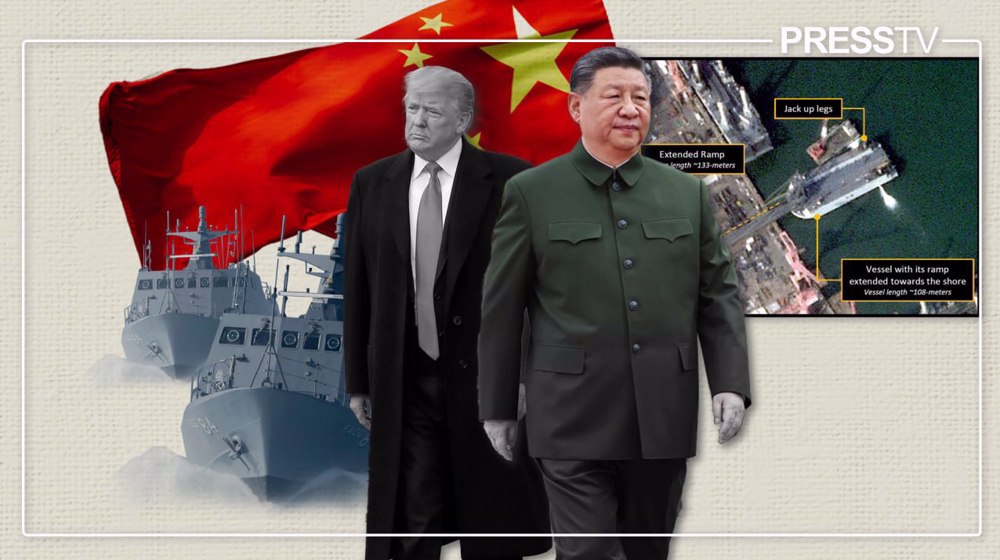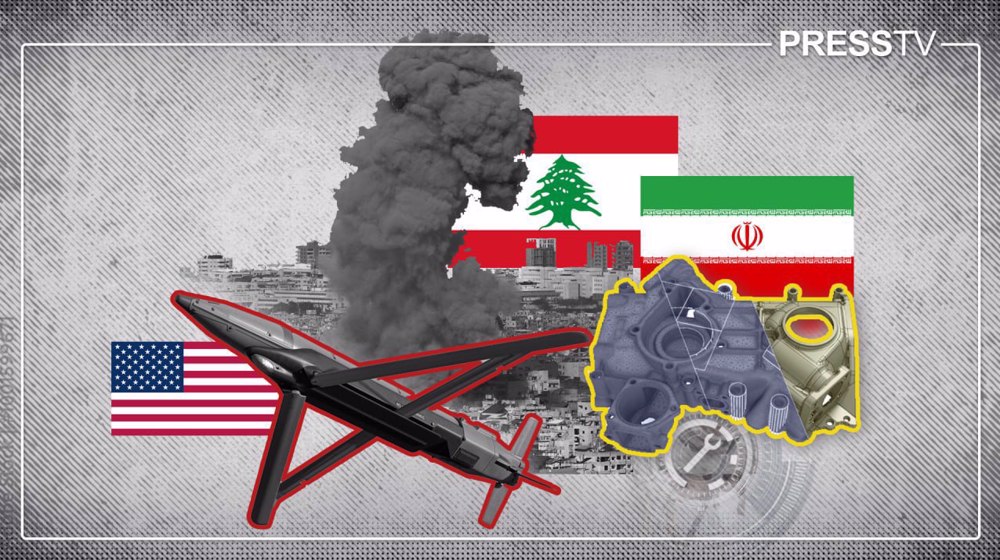How China’s strategic military buildup can deter US economic warfare
By Sayyed Pezhman Madany
Recent satellite imagery has revealed China’s rapid construction of a fleet of specialized amphibious assault barges designed with striking precision for potential landings in Taiwan.
This move appears to be a strategic countermeasure against US President Donald Trump’s aggressive economic policies, transforming financial confrontation into a high-stakes geopolitical chess match between the two arch-rivals.
The design of these barges echoes the legendary Mulberry Harbours that enabled the D-Day invasion of World War II, hinting at China’s ambition to establish mobile military infrastructure capable of bypassing conventional beachheads.
These vessels can dock with larger ships and deploy long bridges to unload tanks and military vehicles directly onto Taiwan’s roads. Some even feature “jack-up” pillars, ensuring stability in adverse weather conditions.
Their accelerated construction pace and unconventional military-leaning design underscore their strategic purpose. Satellite imagery has pinpointed at least seven such barges at Guangzhou Shipyard, reinforcing suspicions of their intended role.
Experts suggest these barges provide China with a flexible, large-scale amphibious assault capability, complicating Taiwan’s defense by opening up new, less predictable landing zones.
Instead of relying solely on traditional beachheads, these mobile piers could deliver armored forces directly to firmer ground, reducing the risk of entrapment in well-defended coastal areas.
This development marks fresh escalation in tensions between China and the US, intertwining military preparations with economic warfare.
With Trump’s return to the White House and renewed threats of economic pressure on China, Beijing’s actions send a clear message: deterrence isn’t just about rhetoric, it’s about tangible military assets.
These barges aren’t merely tools of invasion but statements of intent, signaling that China is prepared to meet the American policy of economic coercion with strategic force.
The stage is set for a geopolitical showdown where military and economic power are wielded as rival weapons, each shaping the uncertain future of the Taiwan Strait.
#China displays full military might with huge anniversary parade#China70years pic.twitter.com/Cpjs3JGTsC
— Press TV 🔻 (@PressTV) October 1, 2019
China’s military preparations and Taiwan
Taiwan stands at the heart of an intensifying geopolitical contest between China and the US, its significance extending far beyond regional geopolitics.
To Beijing, Taiwan is an inseparable part of its territory and to Washington, it is a symbol of a critical ally in the Pacific.
But beyond ideology, Taiwan’s dominance in semiconductor manufacturing makes it an irreplaceable asset—one so vital that a recent US Army assessment warned that a conflict over Taiwan could severely disrupt America’s own military supply chains.
China’s latest military developments, particularly the construction of amphibious assault barges, serve as more than just battlefield preparation. They represent a strategic message.
These specialized vessels, designed to transport heavy military equipment directly onto Taiwan’s roads, grant China greater flexibility in an amphibious invasion scenario.
Their presence alone raises the stakes for the US, demonstrating that Beijing has the capability, as well as the willingness, to escalate tensions if economic pressure becomes too aggressive.
China condemns the US deployment of mid-range missiles in the Philippines as highly dangerous and a threat to regional stability. pic.twitter.com/5H8CER9yNl
— Press TV 🔻 (@PressTV) January 24, 2025
Military muscle as a form of deterrence
China’s military buildup is not merely about preparing for wari, it is about shaping perceptions and influencing decisions.
The deployment of real, operational assets like amphibious barges is a deliberate signal: any economic coercion, especially from Washington, will not go unanswered.
This strategy follows a time-tested principle — actions speak louder than words, and in geopolitics, military actions speak the loudest.
By constructing these barges, China is not just enhancing its ability to fully integrate Taiwan but is also reinforcing its ability to deter American economic maneuvers.
The message is clear: Beijing is prepared to counter financial pressure with force, making military escalation a credible possibility if economic confrontation continues.
In this high-stakes contest, the lines between economic leverage and military readiness are increasingly blurred, and Taiwan remains the most volatile piece on the global chessboard.
Trump, inaugurated for a second term as the 47th President of the United States, has returned with an even stronger resolve to challenge growing and widely expanding China’s economic and strategic dominance.
His first presidency saw an intense trade war between the two sides, marked by sweeping tariffs, trade restrictions, and sanctions designed to curb China’s rise.
If Trump doubles down on these measures, an economic tit-for-tat is all but inevitable, one that could push China to retaliate beyond just financial means.
With Trump aiming to stifle Beijing’s economic growth through aggressive economic maneuvers, China is already preparing for the next round of confrontation.
.@Arnold_August believes that if the United States attempts to use Taiwan as a pawn against China, their defeat on that issue will be much more resounding than their impending defeat in using Ukraine as a pawn against Russia.
— Highlights (@highlightsnews1) April 8, 2023
Follow Press TV on Telegram: https://t.co/7h1TYXZOQt pic.twitter.com/ZJhntW7HnH
Military leverage as economic deterrence
China understands that US economic power, if fully leveraged, could disrupt its technological and industrial ambitions, particularly in critical sectors like high-tech manufacturing.
But instead of relying solely on financial countermeasures, Beijing is turning to military preparedness as a deterrent.
The development of specialized amphibious barges is not just about potential military operations against Taiwan, it is a calculated message to Washington.
These vessels symbolize China’s readiness to escalate tensions if economic pressure crosses a certain threshold. The underlying warning is clear: economic warfare could carry real-world military consequences, forcing the US to think twice before pushing too far.
History has shown that practical, tangible actions are often the most effective deterrents. A notable example occurred in the early 2010s when the US considered an embargo on gasoline imports to Iran.
In response, Iran swiftly ramped up its domestic gasoline production through petrochemical plants, demonstrating that it could neutralize the economic threat.
As a result, the embargo was never fully enforced, a proof that real-world preparation can often dissuade an adversary from carrying out its threats.
Now, China is following a similar playbook. By building military capabilities that could escalate a Taiwan conflict, Beijing is signaling that it has the means to counter Trump’s new economic offensive.
In this new era of global power struggles, economic and military strategies are not separate, but two sides of the same coin.
"Iran, China share geopolitical strategic stance against US imperialism"@NahidPoureisa emphasizes the importance of Iran-China relations, including their strategic stance against US imperialism. pic.twitter.com/gPUlEP8TWe
— Press TV 🔻 (@PressTV) December 28, 2024
The cycle of action and reaction
Trump’s economic policies risk setting off a high-stakes cycle of escalation, where each move is met with a countermeasure —military or economic. Yet, this cycle also serves as a form of strategic signaling: both the US and China understand that their actions won’t go unanswered.
China’s military preparations, particularly the construction of amphibious assault barges, are more than just tools of war; they are calculated warnings.
Beijing is making it clear that any economic assault from Washington could provoke a military response, subtly shifting the risk calculus for US policymakers. The presence of these barges, therefore, is not just about potential conflict. It is about deterrence, using military strength to dissuade economic aggression.
Trump’s economic policies could trigger a cycle of military and economic escalation. Beijing is already working to reinforce its global alliances. Closer ties with Russia, Europe, and other key players could provide China with alternative economic lifelines, mitigating the impact of US sanctions and trade restrictions.
However, China’s military buildup is not occurring in isolation. It serves as a stark reminder that economic warfare does not occur in isolation—when economic leverage is used as a weapon, military power inevitably enters the equation.
For China, economic influence and military capability are interconnected, providing a dual-pronged approach to countering US pressure tactics and regional projects.
The brewing technology war between the US, China
— Highlights (@highlightsnews1) March 15, 2023
Follow Press TV on Telegram: https://t.co/7h1TYXZOQt pic.twitter.com/JRTsvSkblg
Military maneuver and strategic declaration
China’s construction of these specialized amphibious barges is not just a military maneuver; it is also a strategic declaration.
By physically demonstrating its capacity for military escalation, Beijing is warning Washington that economic warfare will not come without risks. This reflects a long-standing principle in international strategy: real actions, not just rhetoric, determine the limits of an adversary’s aggression.
The case of Iran in the early 2010s is a compelling historical parallel. When the US threatened to impose a gasoline embargo, Iran’s rapid expansion of domestic production neutralized the threat before it could be fully enforced.
Similarly, China’s military buildup, particularly its amphibious capabilities, forces the US to reconsider the full consequences of its hegemonic economic policies.
In this high-stakes and high-voltage contest, it is not just words or threats that shape outcomes—it is the tangible, real-world preparations that define the balance of power.
Sayyed Pezhman Madany is a writer and international relations researcher based in Tehran.
(The views expressed in this article do not necessarily reflect those of Press TV)
VIDEO | Press TV's news headlines
VIDEO | Israeli forces launch wide-scale military operation in Qabatiya, south of Jenin
Trump-backed push brings Jolani regime, Israel closer to deal: Israeli media
VIDEO | Iraqi govt. rejects any kind of normalization with Israeli regime
VIDEO | Venezuela's medicine prices soar to unaffordable level amid US blockades
Somalia officially demands Israel reverse recognition of Somaliland
Hezbollah condemns deadly terror attack on worshippers in Syria’s Homs
VIDEO | US military build-up in Caribbean










 This makes it easy to access the Press TV website
This makes it easy to access the Press TV website